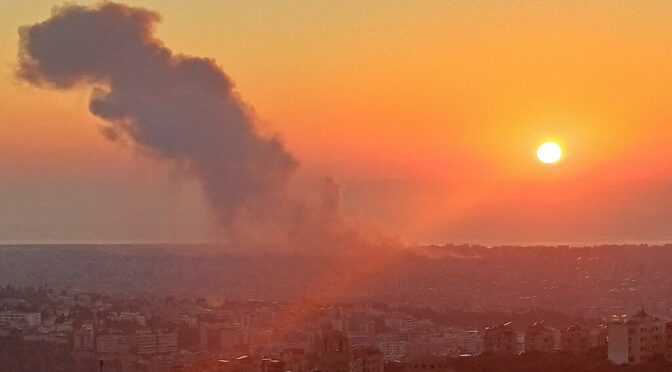Article published in The Daily Telegraph, 27 November 2024. © Richard Kemp
Whatever happened to Hezbollah’s solidarity with its jihadist brothers in Gaza? That was the pretext for launching its war of aggression against Israel the day after Hamas’s October 7 orgy of murder, rape, kidnapping and torture. Yet despite the Hezbollah leadership’s cast iron guarantees that ‘the Lebanon front will not stop before stopping the aggression on Gaza’, it seems they couldn’t even be bothered to mention the Gaza Strip in their desperation for a ceasefire. Nothing could be more telling of the once hubris-filled Hezbollah’s sorry state after a year of mauling by Israel.
Their leaders have been taken out by the dozen, huge numbers of fighters cut down, rockets and launchers blown to smithereens and all of the village strongholds in southern Lebanon razed to the ground. Many terrorists have fled for their lives into neighbouring Syria in the face of the IDF bulldozer. This has become the fate of the fanatical and murderous gangsters that until recently were thought of as the most powerful paramilitary force the world had ever seen.
The blow that this ceasefire represents to the Iranian regime is every bit as great. Hezbollah, painstakingly built up at enormous expense over 40 years, was their flagship, the most important part of the ‘ring of fire’ put in place to burn Israel to death. The vessel may not yet have been sunk but it is certainly filling up with water. Manning the pumps rather than continuing to fire broadsides was seen by the ayatollahs as the best way of salvaging something from the wreckage.
As the IDF continued to hammer Hezbollah, its remaining leadership also feared uprising by rival factions in Lebanon, where long standing animosities have been held at bay by its hitherto unchallenged stranglehold on the country. It’s not clear whether that might yet materialise but you can imagine the fear such a prospect would seize in the Supreme Leader and his henchmen who themselves are having to hold off growing dissent at home.
Adding to the woes of Hezbollah and its Iranian masters is the imminent arrival of Donald Trump in the White House. He is going to usher in a new era in Middle East relations with every probability of less restraint towards Iran and its terror proxies. Recognising that peace and stability is achieved not by fear but by strength, Mike Waltz, Trump’s choice for National Security Adviser, says: ‘We will not tolerate the status quo of Iran’s support for terrorism.’
So much for Hezbollah and its puppeteers in Tehran. But why is Israel agreeing to a ceasefire while it holds the upper hand over the terrorist gang that forced tens of thousands of citizens to evacuate from their homes in the north? There are two major issues, both to do with US pressure.
First, if this ceasefire had not been secured, it is probable that Joe Biden would have allowed through, and even himself orchestrated, a binding UN Security Council Resolution demanding a cessation of hostilities, potentially accompanied by a UN-mandated arms embargo on Israel. It would have been his cynical last ditch effort to rescue something at least from his woeful legacy on foreign affairs. Second, as Prime Minister Benjamin Netanyahu alluded to during his speech on the ceasefire, the Biden White House has been imposing a partial arms embargo against Israel that included vital munitions and combat equipment including 2,000 pound bombs. After more than a year fighting a war on seven battlefronts that is a significant constraint.
Despite Biden’s efforts to hogtie Israel, there is still more work to be done against Hezbollah. Therefore the current ceasefire can best be seen as a diplomatic bridge between Joe Biden’s White House, intent on appeasing Tehran, and a Trump administration that is likely to be much more supportive of Israel’s defensive needs.
Nowhere will that be more important than over the Iranian regime. As well as directing, funding and arming the war against Israel, Tehran has been behind proxy attacks against US forces in Iraq, Syria and Jordan, strikes on Saudi Arabia and the UAE and assaults on international shipping in the Red Sea. Twice since last April, Iran has launched major missile attacks directly into Israel. As with its actions in Gaza and Lebanon, Israel’s response to those was constrained by US pressure.
More dangerous still, Tehran is on the cusp of achieving a nuclear capability to threaten Israel, the Middle East and the world. But Iran is now exposed more than ever before. The primary purpose of Hezbollah’s massive arsenal of rocketry, more extensive in number than most sovereign nations possess, was to deter against Israeli or US military assault on Tehran’s nuclear weapons programme. That deterrent is largely gone and the IDF substantially destroyed Iran’s air defences in its retaliatory strikes in October.
That means Israel is in an unprecedented position to put a stop to the Iranian menace. Decisive action against the Islamic Republic was a red line for Biden. But we must hope that Trump will give Jerusalem a fair wind, both to scuttle Iran’s nuclear project and to put some more holes into Hezbollah’s rotting hull.
Image: Air strike on Hezbollah headquarters by IDF on September 27, 2024 (Source: Jimmyp84/Wikimedia Commons)

